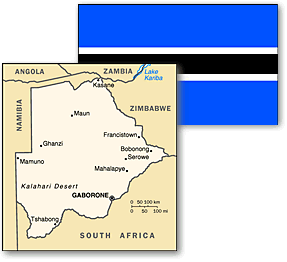 Snapshot of Botswana Location: Botswana is a landlocked country in southern Africa. It is bordered on the west andnorth by Namibia. It is bordered on the east by Zimbabwe. South Africa is situated on thesouthern border of Botswana. Land Area: Botswana covers approximately 224,710 square miles, about the size of Texas. Terrain: Botswana's landscape is composed of deserts and savannas. Climate: The climate of Botswana is mostly sub-tropical. Population: Though the land area of Botswana is quite large, the population is relatively small.Only 1.5 million people live in Botswana. The largest two ethnic groups in Botswana areTswana (55%-60% of the country) and Kalanga (25%-30%). Language: The official language of Botswana is English. However, the languages of Setswana andIkalanga are also spoken. Religion: 60% of the population of Botswana is Christian, while 40% practice indigenous faiths. Major Cities: Gaborone is Botswana's capital and its largest city with a population of about175,000. No other cities in Botswana have a population greater than 100,000. Government: Botswana has a multi-party parliamentary democracy, which has its roots in the villagecouncils of it's tribal culture. Botswana achieved independence from Britain in 1965.National elections occur at least once every five years. The president of Botswana is SirKetumile Masire. Economy: Botswana has had very strong economic growth since the mid-1970's. The stability ofBotswana's democracy has encouraged international investment, and allowed Botswana tobenefit from its most valuable natural resource: diamonds. Botswana is an active member ofnumerous regional and international economic organizations. A modern telecommunicationsand transportation infrastructure has allowed Botswana to link its people to one another. Flag: The flag of Botswana contains a blue field with a horizontal, white-edged black band inthe center. | 
